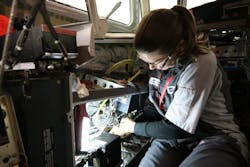Matt Nelson, satellite operations manager, Duncan Aviation, joins AMT in this edition of the Director of Maintenance Discussion, to discuss ADS-B installation and what Duncan Aviation is seeing now that the FAA’s mandates on ADS-B have come and gone.
AMT: With the ADS-B deadlines now well in the rearview, what are you seeing today?
Nelson:
We're seeing three things. Number one, aircraft that met the ADS-B mandate with equipment that would simply allow them to do that – meet the mandate, no other bells and whistles, no ADS-B In, no extraneous equipment.
The other market we're seeing are smaller aircraft, single and twins that never planned to have ADS-B installed because they didn't fly in controlled airspace typically. But those airplanes have traded hands enough that now they need ADS-B installed.
Third is, especially over the last 18 months or so, we have seen a large influx of aircraft being removed from mothballs and restored to a point where they could be sold, or imported from other countries so that they could be sold. There was a severe shortage of used airplanes on the market for brokers to sell. We saw it right here among our own aircraft sales group. So we saw a lot of airplanes that were bought or that were imported from Asia-Pacific, Australia, those types of areas that had a DO-260A version of ADS-B installed. And in the United States, a DO-260A won't meet the requirements for ADS-B mandate in the domestic U.S.
AMT: How many planes do you see coming in to get ADS-B work done?
Nelson:
We see a few a month of all classes, so singles, twins, turboprop, heavy turbine. It runs the gamut.
AMT: Walk us through the general process of what happens when a plane comes in for an ADS-B install.
Nelson:
The general process is customer request followed by a survey of what equipment is currently installed in the airplane, and then best path forward in terms of certification of the equipment going into the upgrade, and then price negotiation, schedule negotiation, touch labor, and then final sign-off, return to service.
AMT: When you’re surveying the equipment already onboard, what is it you’re checking for?
Nelson:
So we would typically look for is there equipment in the airplane that only requires an upgrade, or equipment that needs to be completely replaced? And is there certification available for the pairing between the GPS source, the WAAS GPS source and the transponder or ADS-B transmission destination?
So the way the FAA tried to fast-track ADS-B installation is rather than having to certify each individual installation or product being installed in the airplane, what they allowed was the pairing. They called it a pairing between the GPS source and the transponder. We already knew that the transponder and the GPS could talk to and understand each other, that was the basis for the certification of ADS-B.
AMT: Are you seeing the people who were originally happy with having the barebones to meet the mandate setups choosing to now upgrade?
Nelson:
Yeah. That's pretty popular actually. They're wanting the benefits of WAAS approach, being able to perform WAAS approaches. So it really has nothing to do with ADS-B other than now you're feeding the ADS-B system, the transponders, with the exact same information that is navigating the airplane, as opposed to a dumb sensor that just tells it where it's at basically.
AMT: On the maintenance side, anything to keep in mind when working on these systems?
Nelson:
There are all kinds of new wrinkles in the maintenance area. So, we've come to find out that we are having to double and triple shield transponder antennas when testing pitot-static systems. If we're performing a two-year cert on a particular airplane with ADS-B installed, we have to pull the breakers on the transponders before we run that system all the way up to altitude to test it because if all of a sudden we leak ADS-B information into the atmosphere in the neighborhood of a very busy airspace, say, like Oakland, we could cause all kinds of havoc with aircraft coming in to land or taking off or overflying the airport because now all of a sudden we're reporting an ADS-B target.
It's not moving, but it's basically a concrete column all the way up to 40,000 feet because you don't know what it is, but it's not moving. You can guess it's an airplane under maintenance, but the FAA doesn't care. So shielding of the antenna systems is a maintenance item that under test is something that we're having to get used to.
About the Author
Walker Jaroch
Editor
Contact: Walker Jaroch
Editor | AMT
+1-920-568-8399
>> To download the AviationPros media kits, visit: Marketing Resource Center
>>Check out our aviation magazines: Ground Support Worldwide | Airport Business | Aircraft Maintenance Technology

